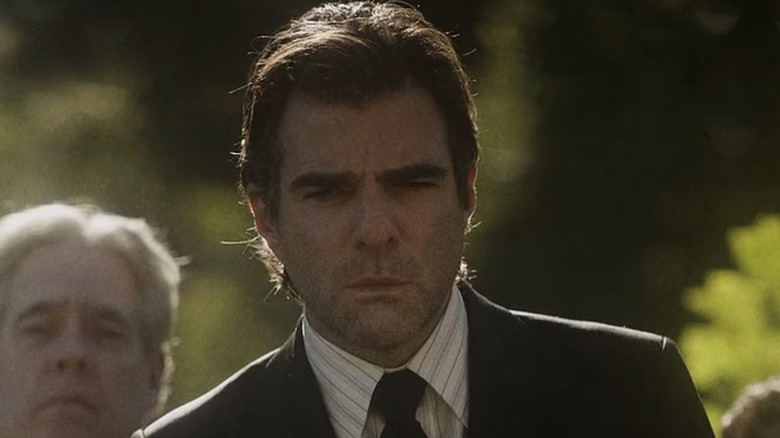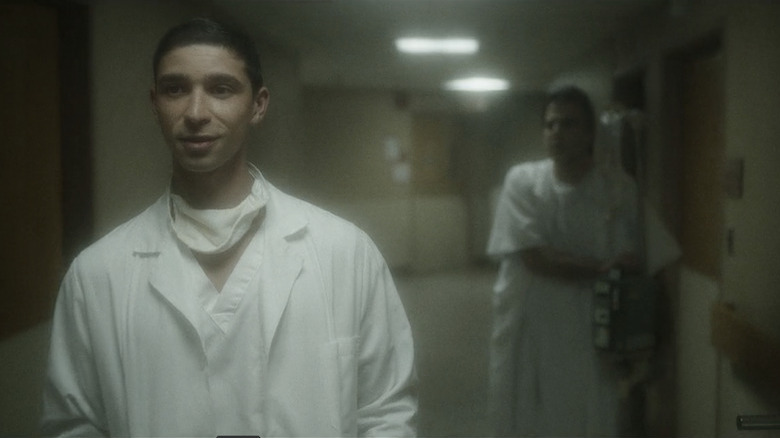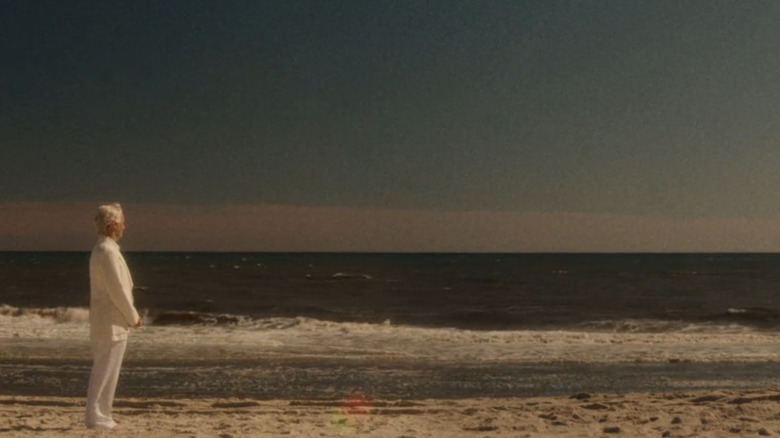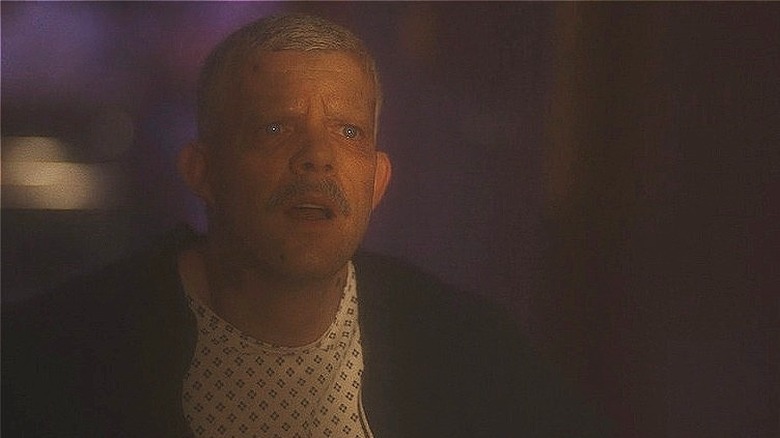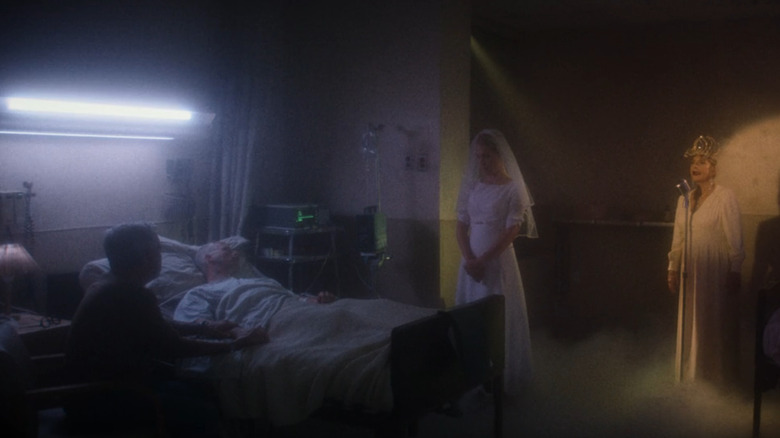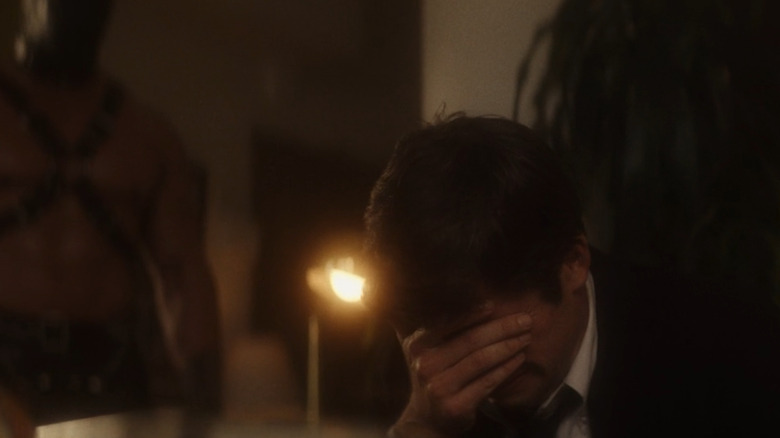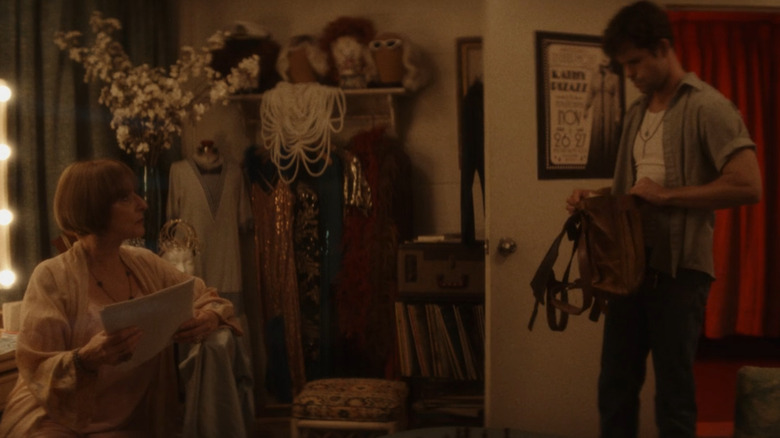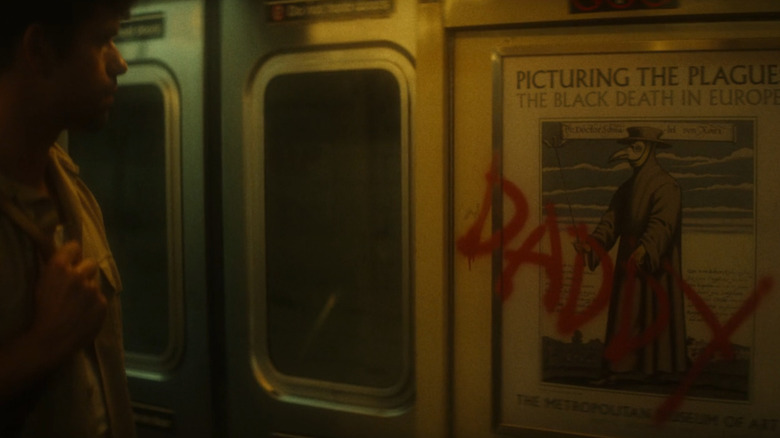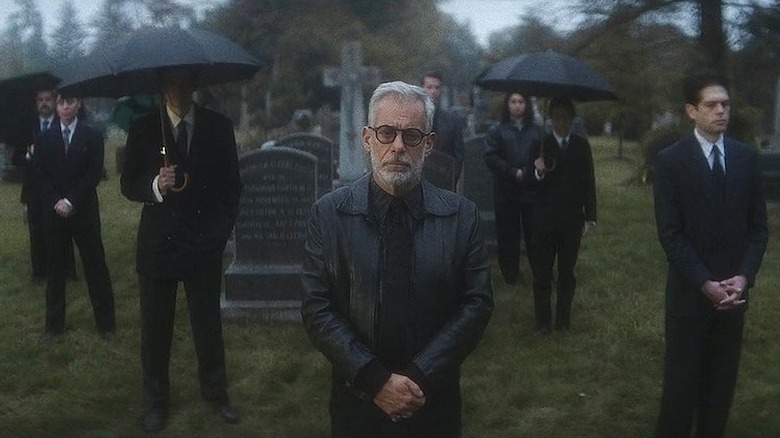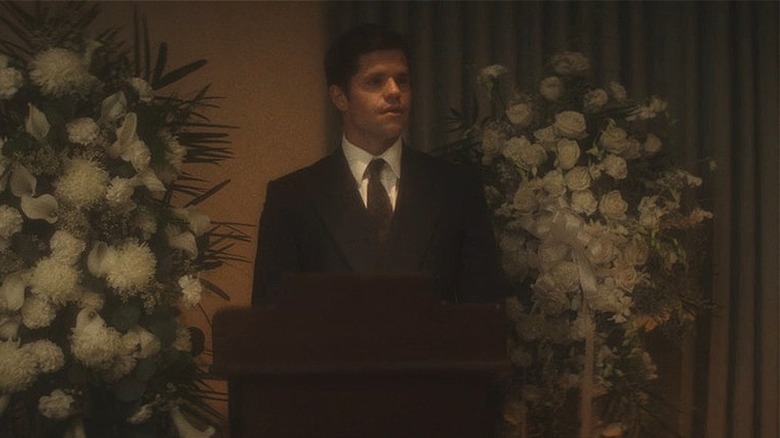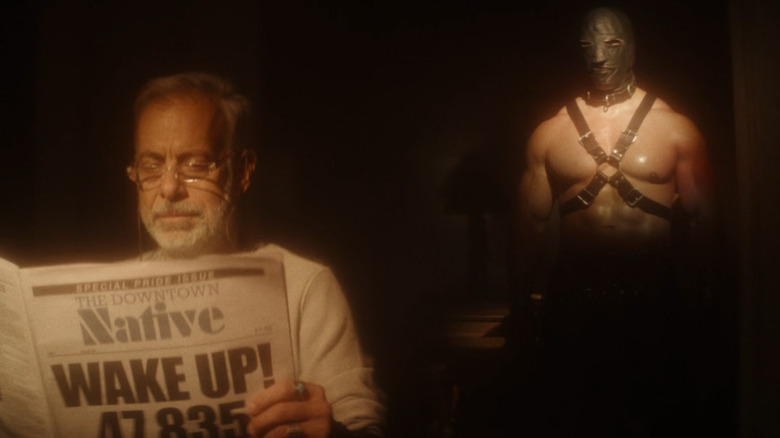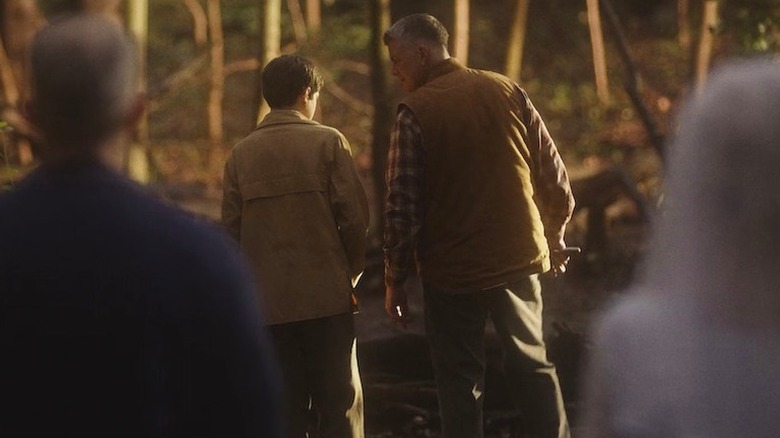American Horror Story: NYC Episodes 9-10 Recap: Monstrous Metaphors
The penultimate episode of "American Horror Story: NYC" certainly doesn't waste any time in picking up in the wake of previous events. As a refresher, the last moments of Episode 8 see Theo (Isaac Powell) drugged and bound in the woods by Sam (Zachary Quinto), though Theo begins to see visions of both Big Daddy (Matthew William Bishop) and several mysterious scantily clad men with deer antlers. Episode 9, titled "Requiem 1981/1987 Part One" starts with a funeral procession of cars driving through a cemetery, and it is revealed that is indeed for Theo. Many are in attendance for the avant-garde photographer, but the most shocking is Sam, who is essentially partially responsible for his death.
Catching Big Daddy out of the corner of his eye, Sam passes out in the middle of Theo's service. Sam then awakens in a dilapidated hospital among flickering lights where he is, amazingly enough, greeted by Billy (Danny Kornfeld) and Theo, who are both in medical garb, with Theo taking the position of a doctor. Confused, Sam wonders what is going on and why he is in such a place, only for Theo to tell him that nobody else would take him in or care for him. Considering that both Theo and Billy are dead, one might wonder if Sam is hallucinating, passed out, or dead and stuck in some kind of purgatory.
Sam appears to be in some kind of purgatory in AHS: NYC
As Theo shows Sam all sorts of victims of the deadly Fire Island virus, Theo informs Sam that he will share the same fate. Sam and Theo then return to Sam's hospital room, where they come face to face with a languishing Sam, who is all alone. Despondent, Sam wonders why there isn't anybody with him and why he is in such a state, and Theo replies that Sam was celebrated and not loved and that there is a very important distinction between the two. The two then witness the hospital bed-bound version of Sam begin to cough and lash out, which causes the witnessing Sam to demand help. The scene then shifts to Sam locked in his own cage among a black abyss, which really drives the point that this is either an extended nightmare or purgatory meant for atonement.
At this point, Henry (Denis O'Hare) appears and begins to talk about Sam's sadism and egotism. Although Sam is initially combative to Henry's statements, Henry begins to show Sam different moments in his life, which causes Sam to finally consider what is being said to him. Sam is then placed on a torture rack, while Big Daddy wears an executioner's style hood. Sam yells at Big Daddy and Henry and tells them that he isn't afraid, though Sam's lashing out to break free says otherwise.
Sam appears to have died alone, and his ashes are scattered by Henry
Finally free of his binds, Sam crashes from the torture rack and appears on a sun-swept beach on Fire Island, which is in front of his party house. Henry and Big Daddy are there as well, and Big Daddy begins to chase Sam, who struggles to pick up traction in the sand. Big Daddy eventually catches Sam, and Sam cries out in fear before noticing some of the scantly clad deer-men from the previous episode. Sam then stops fighting and turns to face his attacker. Sam removes Big Daddy's hood and sees a tall blond man, and the two kiss. Henry comments that Sam has finally reached acceptance of his life and actions as the deer-men, with Theo among them, approach Big Daddy and Sam. Everybody then disappears, while Henry approaches the waterline of the ocean while holding an urn, which he then opens and pours into the ocean.
In other words, this entire sequence between the hospital, cage, and beach may have been the fevered dream of a dying brain, or perhaps something more spiritual like the aforementioned purgatory. The answer is never really implicitly explained, and what has transpired is really left up to the viewer. Is Sam atoning for his transgressions, or is this what one experiences during death? Either way, at this point in "American Horror Story: NYC," Sam has died alone and Henry was given the duty of scattering his ashes, which helps to explain why Sam had noticed his beach property. All of these scenes were laden with allegory and metaphors, which continues throughout these two final episodes.
Patrick is the next to be visited by visions
Shifting gears, "American Horror Story: NYC" then cuts to Gino (Joe Mantello) as he walks through what appears to be the hospital from Sam's earlier out-of-body experience and/or hallucination. Much like the previous hospital scenes, Gino is shocked at the lack of nurses and doctors — or much else of anybody other than patients. Gino is clearly distressed and agitated, and he finally comes to the room where Patrick (Russell Tovey) is in rough shape. Covered in open wounds with milky eyes, Patrick looks incredibly sick. It is then established that this is taking place in 1987, which is six years after the bulk of the story for "AHS: NYC."
Disgusted by Patrick's state and the disarray of the hospital, Gino slams on the button to summon a nurse or doctor. This results in the appearance of an individual in full hazmat gear who tells Gino and Patrick that Patrick is now permanently blind from the Fire Island virus. As Gino expresses his frustration, Patrick tells him to calm down and just be there with him because he is scared. Patrick's next scene has him all alone, and he awakens in his bed and fumbles for his nurse call button, which falls on the floor. Patrick then struggles to find it, accidentally ripping out his IV, but manages to find a wheelchair in his room. As he attempts to find help in the seemingly abandoned hospital, he soon hears the voice of Barbara (Leslie Grossman), who tells him to open his eyes.
Patrick sees a moment from his childhood, and dies in Gino's arms
Similarly to Sam's experiences, Barbara leads Patrick through different moments in his life, which include meeting Gino, a tryst with a co-worker, and finally a bizarre interaction with Mr. Whitely (Jeff Hiller). This final vision doesn't seem to have actually occurred, and it's more or less about Mr. Whitely believing that Patrick is much like Whitely's stitched-together monster. The metaphor here is that Patrick is a stitched-together creation and that his life is scarred and pieced together by his own hand.
However, there is one last vision Barbara wants to give Patrick, and it involves a moment from Patrick's childhood, where he is receiving firearms instruction from his father, who clearly expresses dismay for homosexuals by using some very loaded language and feels his son is missing the targets because he isn't manly enough. This scene clearly hurts Patrick, who notices that his own ears are bleeding from the point-blank firing of the pistol next to his head.
Cutting back to the hospital, Patrick is next to Gino, and Patrick begins to cry. Patrick then sees Kathy (Patti LuPone), the singer from the Turkish bathhouse, who begins to sing a very sad song. As Gino consoles Patrick, both Barbara and Big Daddy appear in the room, with Barbara exchanging a quick glance with the leather-clad mystery man. The scene ends with Patrick dying in Gino's arms, and Gino is left all alone. Again, the hospital appears to be some kind of place of reflection, as both Sam and Patrick see different important moments in their lives, and upon their acceptance of what has transpired, pass from this mortal coil.
Adam believes somebody has killed both Hannah and Theo
Part 2 of the finale for "American Horror Story: NYC" cuts back to Adam (Charlie Carver) as he leaves Theo's funeral. Heading toward the apartment of Hannah (Billie Lourd), Adam sees lots of law enforcement and medical workers surrounding Hannah's domicile. Informed by a tenant and a police officer, Adam is told that Hannah has died, but there are no signs of malicious intent. This is contradictory as to what viewers had seen in a previous episode, where Hannah calls her mother in order to get away from the city and spend some time with her, but Big Daddy is in the background of this call. One can only assume that Big Daddy has something to do with Hannah's death, and Adam is convinced there is foul play involved.
Adam then enters Hannah's apartment and notices her recordings. Sitting down to listen, Big Daddy once again lurks in the background, though Adam doesn't seem to notice. Adam's pursuit of the truth compels him to listen to Hannah's notes on the Fire Island virus, and he eventually hears her struggling to breathe on one of the tapes. Convinced he has found proof, Adam goes to the morgue, and he believes that both Theo and Hannah's deaths are related. Unfortunately for Adam, the coroner (Shirleyann Kaladjian) dashes his theory and says that neither death showed signs of a struggle and that the only tragedy that has occurred is that two people in the prime of their lives have died.
Adam is concerned for the gay community
Adam continues to listen to Hannah's tapes and eventually hears that he himself has the same virus that has killed so many and that Hannah was infected by Adam. Hannah's notes implicate that the virus is sexually transmitted, which causes Adam to reflect on a random hookup in Central Park, where his temporary lover is momentarily replaced by Big Daddy. This scene highlights that Big Daddy may, more or less, be a metaphor, allegory, or primal spirit, and the next moments of "AHS: NYC" see Adam drowning his sorrow in alcohol and getting tested by a doctor (Tony Chiroldes). The doctor tells Adam the test results will be available in seven to 10 days, but Adam says he already knows what it is, and just needs confirmation.
Although the doctor doesn't understand how Adam can know such things, Adam implores the doctor to tell his patients and coworkers about the virus, and that the virus is something that requires additional research and resources. Adam continues to take matters into his own hands and begins to print out fliers that ask people to use protection when engaging in sexual activities — if only to slow down the rapid transmission of the virus. Adam then heads to the Turkish bathhouse where he asks Kathy to place some of his fliers, but she informs him that she is closing up shop because something dark is in the air, and the whimsy she used to crave is long gone. She then adds that Adam needs to remember to live, and not be so obsessed with death.
AHS: NYC establishes that the Fire Island virus is HIV and AIDS
Taking the subway home, Adam sits down in front of a poster for a museum display involving the Black Plague, but there is graffiti on it that says "Daddy." This is really a direct implication that Big Daddy isn't a ghost or something to that tune, but rather a manifestation of the virus. The homeless woman (Chris McGinn) from earlier in the season then appears between flickers of light, and she once again tells Adam that he was warned about the coming darkness before she disappears and leaves a newspaper in her wake that says a mysterious cancer is sweeping through the homosexual community. This woman may represent the growing fear and paranoia in Adam, who has been fairly skittish and concerned throughout all of the episodes of "American Horror Story: NYC."
Engaging in another time jump, "AHS: NYC" picks up in 1987, and follows Gino into a pharmacy picking up medicine. Before he enters, he notices a sign talking about a drug that can help with AIDS, and this is the first time that term is really used in "AHS: NYC." In the previous episodes, the virus is always referred to as the "Fire Island virus," but now it has crossed over into reality with the actual proper terminology. This means that "American Horror Story: NYC" is really another way of looking at the AIDS epidemic and scare of the 1980s, and that many of the supernatural elements of the show aren't ghosts or anything like that, but rather a physical embodiment of many of the gay community's fears.
An extended sequence shows the carnage AIDS inflicts on the gay community
As Gino leaves the pharmacy, he notices reflections of himself and Patrick in windows and mirrors, which shows just how much Gino has been suffering since Patrick's death. Viewers then get a chance to see where Gino is headed, and it's to Patrick's funeral. Gino attempts to talk with Patrick's parents, though they immediately spurn his kind gesture. Although Gino takes this in stride, he notices that it is a closed-casket funeral, which immediately enrages him and causes him to lash out at the crowd. However, this is revealed to be a figment of Gino's imagination and sorrow. His daydream is really just a way of him expressing his anger and frustration at the world at large and how nobody seems to really care about Patrick.
As Gino prepares to sit down, he notices Big Daddy about to deliver a eulogy, and the lights begin to flicker. An extended sequence then plays, featuring a song from Kraftwerk called "Radioactivity," which begins with Gino watching Patrick's coffin lowered into the ground — though the undertaker is Big Daddy. Several more men then march into the grave, falling face first before Big Daddy.
At this moment in "American Horror Story: NYC," metaphors and allegories make up the bulk of the remaining episode, as the years waste away and more and more men are seen walking directly into the grave. Gino is seen attending AIDS rallies, writing stories, and lamenting his lost love all the while Big Daddy is continually digging, or wielding machine guns, cutting down Gino's friends and co-workers. Again, Big Daddy isn't actually there, and this is a symbol of the carnage wrought by the AIDS epidemic.
Gino's final moments has him see Patrick, while Adam struggles to deliver a eulogy
Gino's decline is slow, and he is constantly trailed by Big Daddy, who at one point during the sequence is a bartender in a red-washed scene who is pouring out green drinks to Gino and his fellow patrons, who are wearing hospital gowns. Another scene has Gino walking down the streets of New York City and everybody that passes him is wearing a skull mask. In other words, Gino is feeling death closing not only on him but his community as well. Though the denizens of NYC aren't actually wearing these masks, it shows exactly what kind of state of mind Gino is in, and how much pain and isolation he is feeling.
Gino's final moments see him struggling to breathe in his bed and the cemetery, but both locations have Big Daddy staring onward. During his last breath, Gino sees Patrick in a halo of light, which invokes one last smile from the reporter. "American Horror Story: NYC" then ends at Gino's funeral, where Adam struggles to summon forth enough composure to deliver a eulogy. Before viewers get a chance to hear his words, the episode is over, and nothing is said. This lack of a statement could be a statement in and of itself because so much death has occurred.
Big Daddy was never a ghost or person, but represents AIDS
This season of "American Horror Story" is definitely different than most other iterations of the show, and its fear and terror are firmly based on reality. The only real supernatural element was that of Big Daddy, and now that the season is over, one can see that the character was never real in a traditional sense, but rather a phantasm born of AIDS. This is the reason why he always appears and seems to herald death, and why the cops were never able to apprehend him. Some may wonder how Big Daddy — since he is more or less a metaphor — is able to firebomb that house in one of the earlier episodes, but again, this could be an allegory to the sexual escapades taking place in the house, and how something like AIDS could spread like a wildfire in such an environment. Either way, "AHS: NYC" is definitely a vessel for the AIDS pandemic, and Big Daddy represents the ominous and fearsome aspects of the disease in the 1980s.
There are several themes that make up the soul of this particular "AHS" season. Of course, the biggest one, and the one just discussed, is the nature of Big Daddy, who many thought was some kind of killer or ghost. Eventually revealed to be neither, Big Daddy actually represents the lurking nature of something like AIDS, which probably explains why he is only noticed by some, and ignored by many.
Acceptance and secrets are a big part of American Horror Story: NYC
Likewise, another big aspect of "AHS: NYC" is secrets, which require several episodes to be unwoven. If people were more upfront about their proverbial skeletons in the closet, as well as their wants and desires, the issues of trust wouldn't have been present through so many episodes. This is probably best illustrated by Patrick's story arc, which sees him hide parts of his personality from his loved ones, as well as parts of his past, which is probably explained by Patrick's abusive and homophobic father and the unnecessary shame he feels from his lifestyle choices.
Acceptance is another big issue of "AHS: NYC," which is based on real-life situations during the 1980s. With the growing pride of the gay community during this decade, some people were weary of this new culture and lifestyle, which is noticeable in the homophobic remarks of police officers. Had society been more open, the disease (and by extension Big Daddy) probably wouldn't have created such death because it would have been treated as more of a threat. Since viewers never got a chance to hear Adam's eulogy for Gino, it can also be assumed that the creators purposefully chose silence, as so many voices were silenced because of AIDS. Ultimately, "AHS: NYC" may have lacked the typical chills and thrills of the show, but it made up for it in real-life horror.
